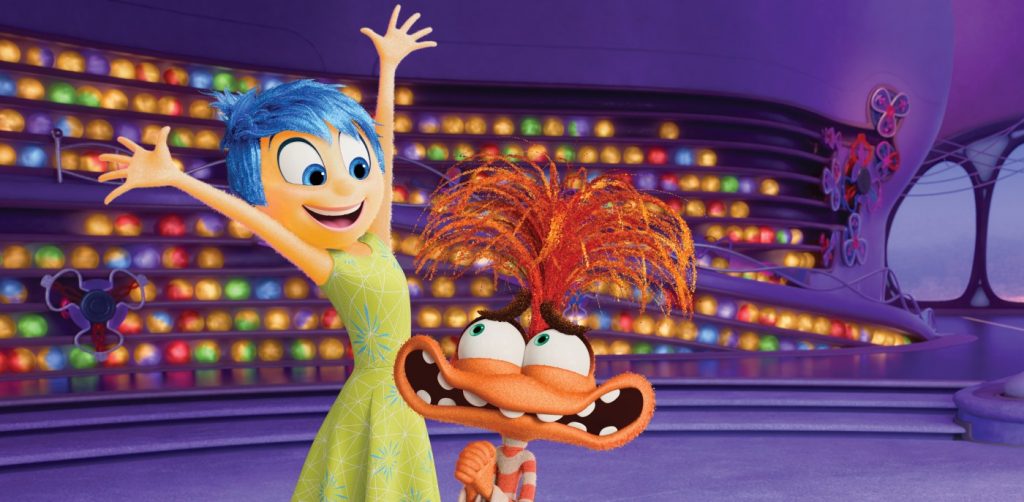Not many teens want to talk about anxiety, these days.
Can you blame them?
Related Articles
‘Bad Boys: Ride or Die’ review: Smith-Lawrence comedic chemistry gives it life
What to watch: Spoiled racist NBA owner gets his due in satisfying ‘Clipped’
‘Robot Dreams’ is deeper than you might expect
What to watch: ‘Violent Nature’ more than lives up to its name
Review: ‘The Beach Boys’ is a sentimental documentary that downplays the band’s squabbles
It is, after all, a red-alert, all-hands-on-deck emotion that seems determined to yank control from all of us. And that’s especially true for a younger generation that’s expected to someday take the reins of the world, having already experienced a worldwide pandemic. global warming, social media pressures and more.
But Pixar is here to help.
The Emeryville studio’s new film “Inside Out 2” extends a compassionate hand to young and old alike with a warm-hearted but sophisticated message about how to deal with anxiety, not to mention the galaxy of other emotions that threaten to run away with our lives.
“Inside Out 2,” of course, is the follow-up to the 2015 box-office smash (a global cha-ching of nearly $859 million) that focused on personified emotions wrestling for control of the mind of a young girl, Riley. The sequel serves up — you guessed it — more emotions, as frazzled Anxiety (voice of Maya Hawke) and her pubescent cohorts Envy (Ayo Edebiri), Embarrassment (Paul Walter Hauser), Ennui (Adèle Exarchopoulos) and Nostalgia (June Squibb), join the scrum with holdovers Joy (Amy Poheler), Sadness (Phyllis Smith), Anger (Lewis Black), Fear (Tony Hale, placing Bill Hader) and Disgust (Liza Lapira) of 13-year-old San Franciscan Riley’s mindset.
The last time we met Riley she was 12. In “Inside Out 2,” she crash-lands into puberty while at a Northern Californian hockey summer camp, where her emotions scurry around like a puck on ice.
That’s a lot of emotional content to deal with. But the PG-rated film that opens in theaters June 14 had help.
Dacher Keltner, a UC Berkeley professor and co-director of the Greater Good Science Center, served as a consultant on the sequel — just as he did on the original film and for Pixar’s 2020 release “Soul.” This time he worked with director Kelsey Mann, who took over the reins for “Inside Out 2” from Pete Docter, Pixar’s chief creative officer, who helmed the first film.
Keltner hopes “Inside Out 2” helps teens feel they aren’t alone with their teeming emotions and that they could benefit from being OK with all of them.
“There are lessons that will be useful for young people about perfectionism,” he said. “About the fact we have multiple sides to our identities. We’re good and we’re also envious. We are kind and we are also selfish. And that’s how humans are, and I think that’s really important (to realize).”
Tony Hale says he relived the insecurities he experienced during puberty to voice his character, Fear, in “Inside Out 2.” (Disney/Pixar)
Pixar’s more enlightened and nuanced view of feelings appealed to Emmy-winning actor Hale, who replaced Bill Hader to voice Fear. The “Veep” costar says he has firsthand knowledge of what fear is like, and praises “Inside Out 2” for taking a refreshing, healthy outlook about warring emotions.
“What I get most excited about is kids seeing this because when I was a kid during puberty, everything was happening and I’m so confused, and I also feel like I was the only one feeling it and I kind of need to push away these feelings since they’re not helping. This movie shows that these emotions are actually trying to help us. They’re really on our team.”
Fear returns for “Inside Out 2.” (Disney/Pixar)
Nailing what ping-ponging emotions are like for a teen girl required gaining knowledge from specific groups and individuals, along with input from the entire animation team and cast. Mann recalls the first time Keltner came in to discuss the project and the reaction he received when he popped this question: “What happens in our brains when we become a teenager?”
“I remember him leaning back and going: ‘Wow, it’s a lot.”
To give the film more authenticity, Pixar approved Mann’s request to gather input from nine girls (ages 13 to 16) of various backgrounds who lived in various states (California, Washington and Louisiana). They became known as Riley’s Crew.
“They were incredibly helpful, supportive and smart,” he said.
Mann’s grateful that Pixar went for the idea and considers the Riley’s Crew contributions, culled after screenings of key sequences during a three-year span, to be invaluable.
To be more honed in on a female perspective, screenwriter Meg LeFauve got tapped to write the airtight screenplay.
It was important to get all those details right, Mann said.
“I really want everyone to enjoy this movie regardless of your age,” he added. “But I really want to make sure that the teenagers of today are connecting to the storytelling.”
Even before COVID-19 exacerbated feelings of anxiety around the world, Mann — who started working on the film in January 2020 when his son was 14 and his daughter 13 — already envisioned that emotion as portraying a pivotal role in the sequel.
In the early phase, Mann wrote up a list of other potential emotions but it was anxiety that kept drawing his interest, since he too had experienced it. Add in the hours of research he had done about today’s youth and the input he received from his advisers, it was clear that Anxiety had earned a starring role.
Mann realizes there’s a lot riding on this sequel and that the original Oscar-winning film was so loved. After rewatching the first one, he was struck by three things: “It was a really fun movie. It’s a really imaginative movie. And it made a meaningful impact on the world.”
“Those are the three reasons why I got into making movies in the first place,” he added. “And if I can do that for a whole new generation … if I can make things just that much better, like the first film did, then why wouldn’t I want to jump at the chance (to make this one.)?”
After seeing a completed version of “Inside Out 2” at the wrap party, Mann said he felt a great deal of pride for the studio, which sadly announced in May that it was slated to cut 181 jobs at its Emeryville headquarters.
“One of my favorite things about the wrap party is at the end everybody’s applauding for all the names and the credits, and it ends with the Pixar logo,” he said. “And it always says ‘made in Emeryville, California’ and everyone just applauds for us collectively as a group.”
But Mann concedes there is an inherent pressure for box office success every time Pixar releases a film, especially during a summer that is generating some dismal revenue projections for Hollywood.
“It’s a little bit of joy and anxiety,” Mann says. Last year’s Pixar release “Elemental” was initially branded a box-office failure when it got released near the same time last year, but it went on to nearly gross $500 million at the U.S. box office. The year before that, “Lightyear” flared out at under $120 million in the U.S. and Canada.
“There’s been a lot of great interest in the movie and that has warmed my heart so much because you put your heart into these movies and you want the world to embrace and love it. … It’s just a great opportunity you get to make something that can make a lot of impact on a lot of people’s lives…
“I’m just more grateful and full of joy than, really, anxiety.”
Contact Randy Myers at [email protected].


